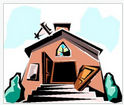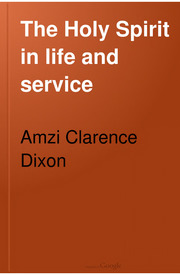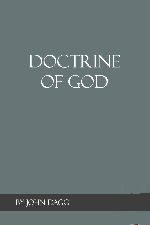Systematic Theology Compendium and Commonplace Book
Systematic Theology
By Augustus Hopkins Strong
A Compendium and Commonplace-Book
Designed For The Use Of Theological Students
By Augustus Hopkins Strong, D.D., LL.D.
President and Professor of Biblical Theology in the Rochester Theological Seminary — Revised and Enlarged
Volume 1
The Judson Press
Philadelphia, Boston, Chicago, St. Louis, Los Angeles,
Kansas City, Seattle, Toronto
1907
Volume 1 of Strong’s Systematic Theology work covers the doctrine of God and the Trinity, and a little bit of why God would reveal information to us. He also has introductory material to theology in this work.
Contents of Systematic Theology Compendium and Commonplace Book
Volume I
Preface . . . . . . . . . . . . . . . . . . . . . . . . . . . . 3
Part I. Prolegomena. . . . . . . . . . . . . . . . . . . . . . 9
Chapter I. Idea Of Theology. . . . . . . . . . . . . . . 9
I. Definition of Theology. . . . . . . . . . . . . . 9
II. Aim of Theology. . . . . . . . . . . . . . . . 10
III. Possibility of Theology. . . . . . . . . . . . . 12
IV. Necessity of Theology. . . . . . . . . . . . . 41
V. Relation of Theology to Religion. . . . . . . . 50
Chapter II. Material of Theology. . . . . . . . . . . . . 61
I. Sources of Theology. . . . . . . . . . . . . . . 61
II. Limitations of Theology. . . . . . . . . . . . . 82
III. Relations of Material to Progress in Theology. 86
Chapter III. Method Of Theology. . . . . . . . . . . . 90
I. Requisites to the study of Theology. . . . . . . 90
II. Divisions of Theology. . . . . . . . . . . . . . 96
III. History of Systematic Theology. . . . . . . . 103
IV. Order of Treatment in Systematic Theology. . 117
V. Text-Books in Theology. . . . . . . . . . . . 119
Part II. The Existence Of God. . . . . . . . . . . . . . . . 121
Chapter I. Origin Of Our Idea Of God’s Existence. . . . 121
I. First Truths in General. . . . . . . . . . . . . . 124
II. The Existence of God a first truth. . . . . . . . 129
III. Other Supposed Sources of our Idea of God’s Existence. . . . . . . . . . . . . . . . . . 143
IV. Contents of this Intuition. . . . . . . . . . . . 154
Chapter II. Corroborative Evidences Of God’s Existence.162
I. The Cosmological Argument, or Argument from Change in Nature. . . . . . . . . . . 166
II. The Teleological Argument, or Argument from Order and Useful Collocation in Nature. . . . . . . . . . . . . . . . . . . 170
III. The Anthropological Argument, or Argument from Man’s Mental and Moral Nature. . . 183
IV. The Ontological Argument, or Argument from our Abstract and Necessary Ideas. . 194
Chapter III. Erroneous Explanations, And Conclusion. 204
I. Materialism. . . . . . . . . . . . . . . . . . . . 204
II. Materialistic Idealism. . . . . . . . . . . . . . 216
III. Idealistic Pantheism. . . . . . . . . . . . . . 227
IV. Ethical Monism. . . . . . . . . . . . . . . . 239
Part III. The Scriptures A Revelation From God. . . . . . . 252
Chapter I. Preliminary Considerations. . . . . . . . . . 252
I. Reasons a priori for expecting a Revelation from God. . . . . . . . . . . . . . . . . . 252
II. Marks of the Revelation man may expect. . . . 258
III. Miracles, as attesting a Divine Revelation. . . 265
IV. Prophecy as Attesting a Divine Revelation. . 303
V. Principles of Historical Evidence applicable to the Proof of a Divine Revelation. . . . 320
Chapter II. Positive Proofs That The Scriptures Are A Divine Revelation. . . . . . . . . . . . . . . . . 328
I. Genuineness of the Christian Documents. . . . 328
II. Credibility of the Writers of the Scriptures. . . 391
III. The Supernatural Character of the Scripture Teaching. . . . . . . . . . . . . . . . . . 396
IV. The Historical Results of the Propagation of Scripture Doctrine. . . . . . . . . . . . . 433
Chapter III. Inspiration Of The Scriptures. . . . . . . . 445
I. Definition of Inspiration. . . . . . . . . . . . . 445
II. Proof of Inspiration. . . . . . . . . . . . . . . 450
III. Theories of Inspiration. . . . . . . . . . . . . 460
IV. The Union of the Divine and Human Elements
in Inspiration. . . . . . . . . . . . 483
V. Objections to the Doctrine of Inspiration. . . . 505
Part IV. The Nature, Decrees, And Works Of God. . . . . 555
Chapter I. The Attributes Of God. . . . . . . . . . . . 555
I. Definition of the term Attributes. . . . . . . . . 556
II. Relation of the divine Attributes to the divine Essence. . . . . . . . . . . . . . . . . . . 557
III. Methods of determining the divine Attributes. 563
IV. Classification of the Attributes. . . . . . . . . 564
V. Absolute or Immanent Attributes. . . . . . . . 568
VI. Relative or Transitive Attributes. . . . . . . . 628
VII. Rank and Relations of the several Attributes. 676
Chapter II. Doctrine Of The Trinity. . . . . . . . . . . 695
I. In Scriptures there are Three who are recognized as God. . . . . . . . . . . . . . . . 698
II. These Three are so described in Scripture that we are compelled to conceive of them as distinct Persons. . . . . . . . . . . . . . 739
III. This Tripersonality of the Divine Nature is not merely economic and temporal, but is immanent and eternal. . . . . . . . . . 748
IV. This Tripersonality is not Tritheism; for, while there are three Persons, there is but one Essence. . . . . . . . . . . . . . . . 758
V. The Three Persons, Father, Son, and Holy Spirit, are equal. . . . . . . . . . . . . . 766
VI. Inscrutable, yet not self-contradictory, this Doctrine furnishes the Key to all other Doctrines. . . . . . . . . . . . . . . . . . 789
Chapter III. The Decrees Of God. . . . . . . . . . . . . 810
I. Definition of Decrees. . . . . . . . . . . . . . 810
II. Proof of the Doctrine of Decrees. . . . . . . . 814
III. Objections to the Doctrine of Decrees. . . . . 825
IV. Concluding Remarks. . . . . . . . . . . . . . 844
http://www.bibleresourcelibrary.com/wp-content/uploads/2018/05/Strong-Systematic-Theology6721.pdf
More Works on Doctrine
- Grudem Systematic theology: An Introduction to Bible Doctrine
- Smith Theology of Charles Finney
- Strong – Systematic Theology v1
- Dagg Manual of Theology
- Simmons A Systematic Study of Bible Doctrine
- Ryle – Old Paths
- Torrey Fundamental Doctrines of the Christian Faith
- Ritchie Foundational Truths of the Gospel
- Smith – Major Bible Doctrines
- Hagler – Rightly Dividing the Word of Truth






